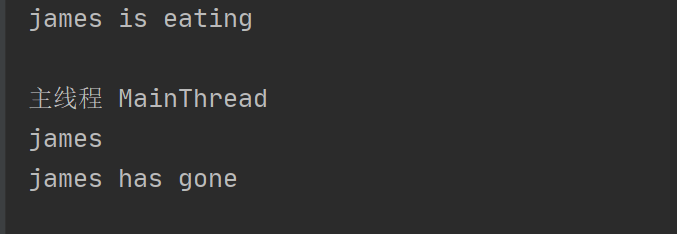什么是线程?
开启线程的两种方式
方式一:
1 import time 2 import random 3 from threading import Thread 4 5 6 def eat(name): 7 print('{} is eating'.format(name)) 8 time.sleep(random.randrange(1, 5)) 9 print('{} has gone'.format(name)) 10 11 12 if __name__ == "__main__": 13 t1 = Thread(target=eat, args=('james', )) 14 t1.start() 15 print(' 主线程')
方式二:
1 import time 2 import random 3 from threading import Thread 4 5 6 class MyThread(Thread): 7 def __init__(self, name): 8 super().__init__() 9 self.name = name 10 11 def run(self): 12 print('{} is eating'.format(self.name)) 13 time.sleep(random.randrange(1, 5)) 14 print('{} has gone'.format(self.name)) 15 16 17 if __name__ == "__main__": 18 t1 = MyThread('james') 19 t1.start() 20 print(' 主线程')
进程与线程之间的区别
- 开进程的开销远大于开线程
- 同一进程内的多个线程共享进程的地址空间
- 同一个进程下的线程的pid是一样的
线程的常见属性和方法
获取线程名称
1 import time 2 import random 3 from threading import Thread, current_thread 4 from multiprocessing import Process, current_process 5 6 7 class MyThread(Thread): 8 def __init__(self, name): 9 super().__init__() 10 self.name = name 11 12 def run(self): 13 print('{} is eating'.format(self.name)) 14 time.sleep(random.randrange(1, 5)) 15 print(current_thread().getName()) 16 print('{} has gone'.format(self.name)) 17 18 19 if __name__ == "__main__": 20 t1 = MyThread('james') 21 t1.start() 22 print(' 主线程', current_thread().getName())

互斥锁
1 from threading import Thread, Lock 2 import time 3 4 n = 100 5 6 def task(): 7 global n 8 mutex.acquire() 9 temp = n 10 time.sleep(0.1) 11 n = temp - 1 12 mutex.release() 13 14 15 if __name__ == "__main__": 16 mutex = Lock() 17 t_l = [] 18 for i in range(100): 19 t = Thread(target=task) 20 t_l.append(t) 21 t.start() 22 23 for t in t_l: 24 t.join() 25 26 print('主', n)
将并发的过程变为串行的过程